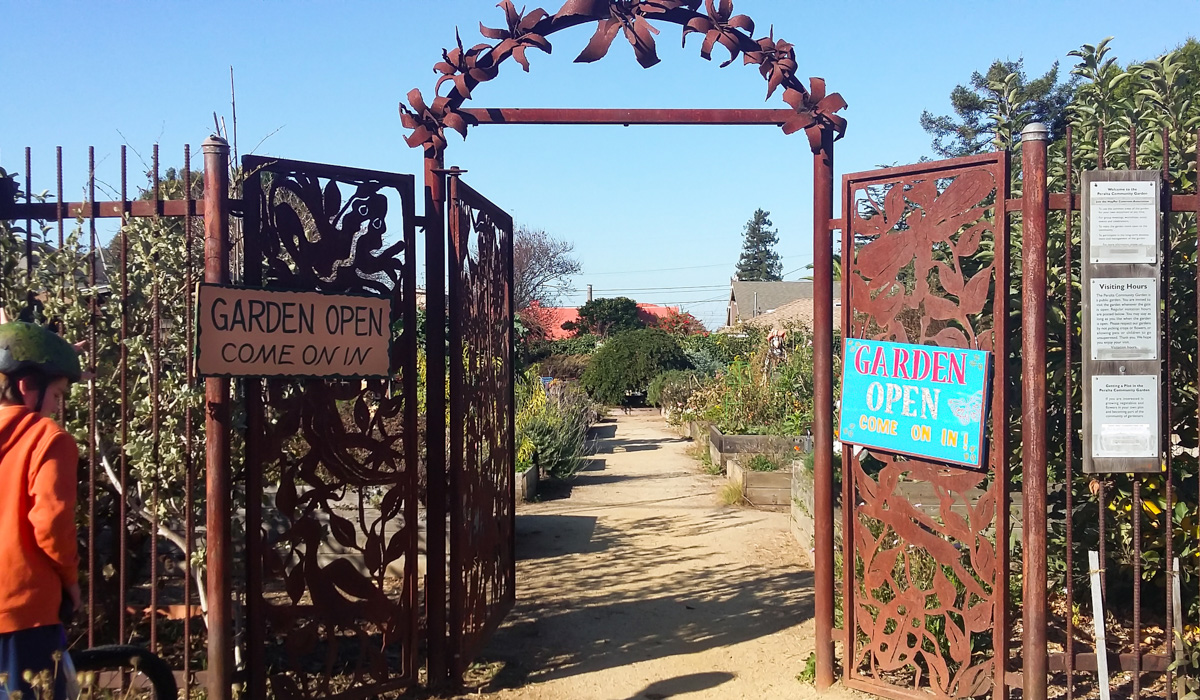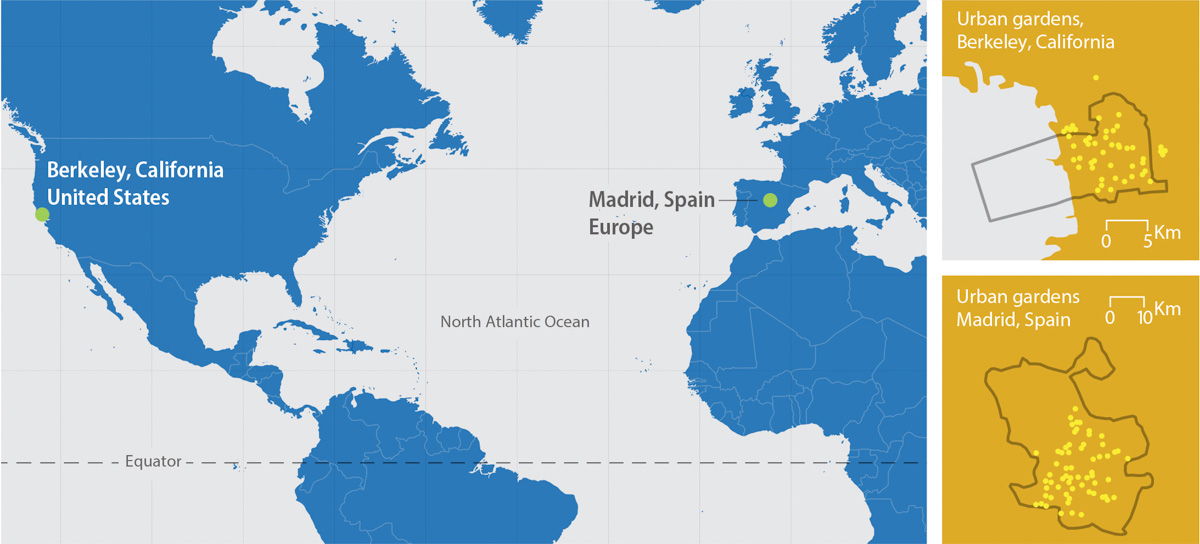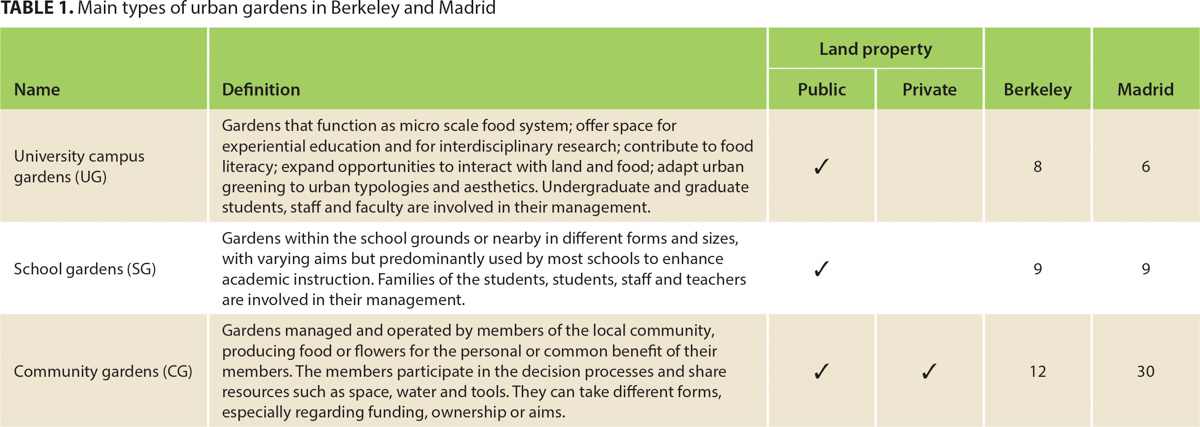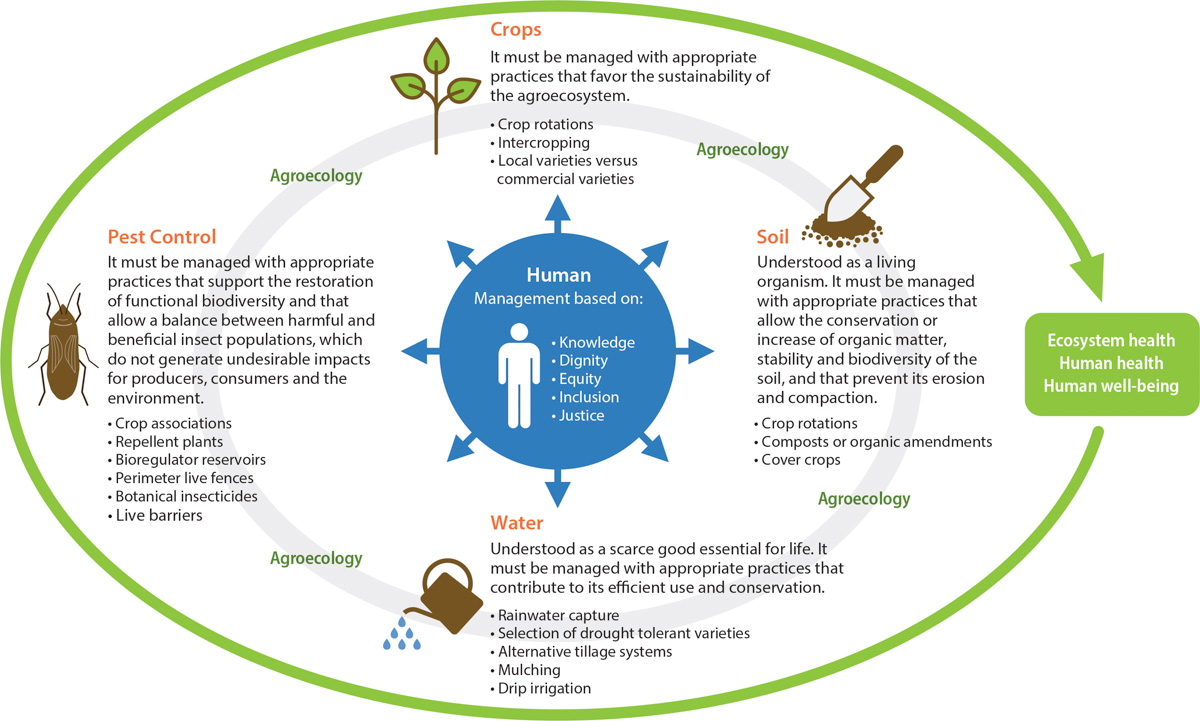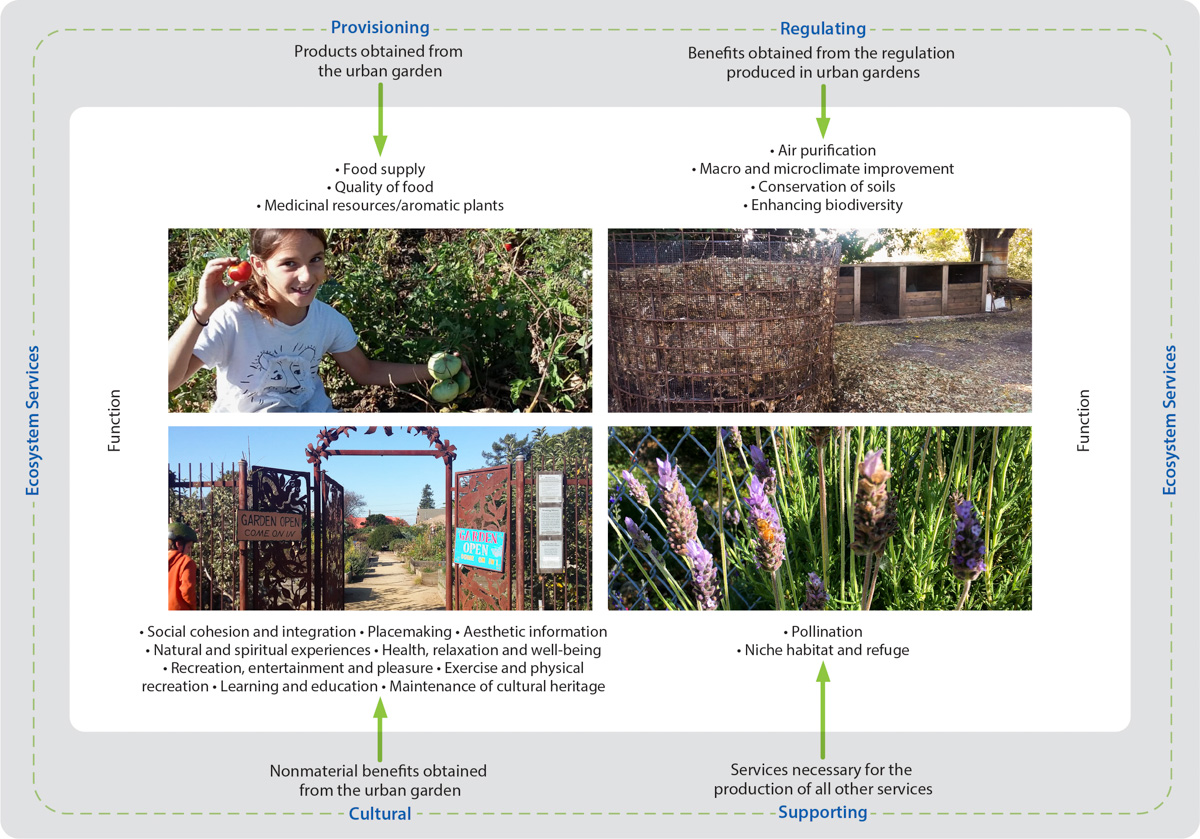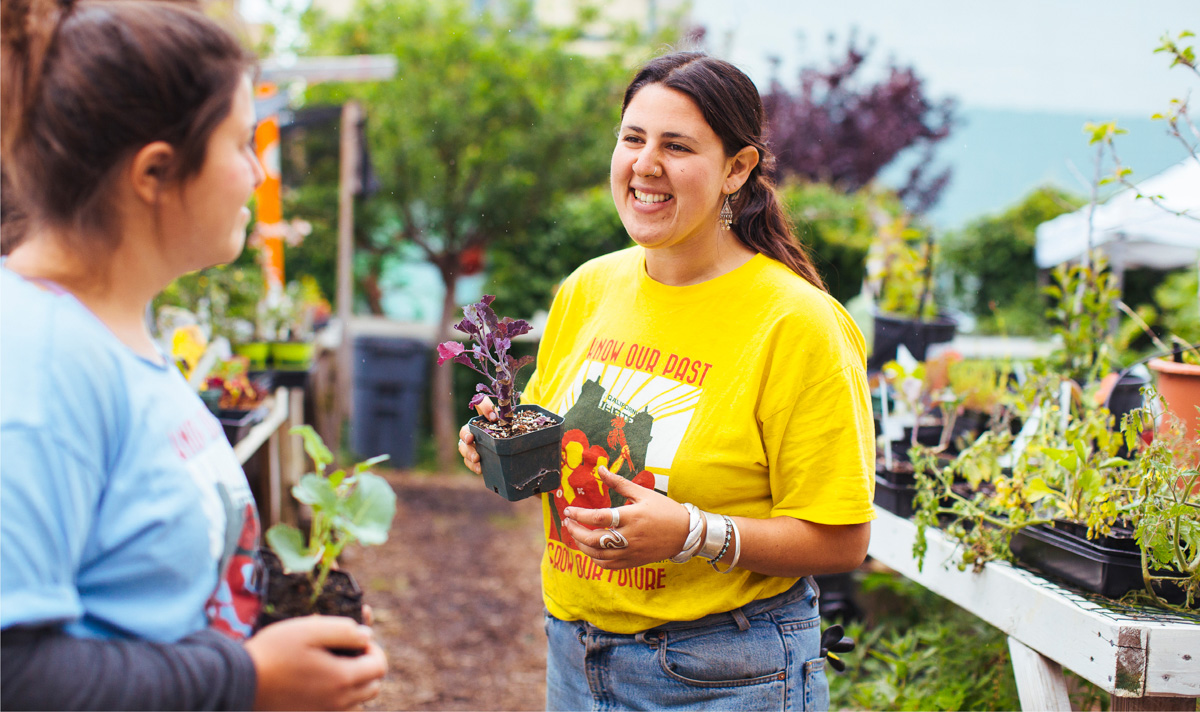All Issues
With sustainable use of local inputs, urban agriculture delivers community benefits beyond food
Publication Information
California Agriculture 76(4):121-130. https://doi.org/10.3733/ca.2022a0013
Published online December 01, 2022
PDF | Citation | Permissions
NALT Keywords
Abstract
Urban agriculture is becoming increasingly important in developed countries, especially in terms of its economic and social benefits. If urban gardens are managed according to agroecological principles - involving the efficient and sustainable use of local resources and inputs - there are many environmental benefits to local communities. We studied urban gardens in Berkeley, California, and Madrid, Spain, to see how agroecology is practiced. Communities such as these that utilize good ecological practices in urban gardens obtain a wide range of valuable ecosystem services - the kinds of services provided by healthy ecosystems, including cultural services such as a place to socialize. These communities can serve as model urban agricultural centers which can contribute to the achievement of the United Nations Sustainable Development Goals, including good health, food security and sustainable cities.
Full text
Ever since the domestication of crops and animals began in the Neolithic period, agriculture has made many social contributions beyond simply producing food (Lovell 2010; Poulsen et al. 2017). Urban agriculture (UA), which is the raising of plants and animals within cities, has a long and multifaceted history in both developed countries (Corcoran and Cavin 2018; Surls et al. 2015) and developing countries (Olivier and Heineken 2017). As in all agricultural systems, UA produces a wide range of non-food products and services that contribute to economic growth while bolstering social and cultural systems. Along with the growing interest in UA, recently there has been an increased emphasis on the ecosystem services (ES) provided by urban gardening, which either directly or indirectly improve city dwellers' quality of life (Wilhelm and Smith 2018). Ecosystem services are the benefits that healthy ecosystems provide. They include “provisioning services” (such as providing food), “regulating services” (such as purifying water), “supporting services” (such as nutrient cycling) and “cultural services” (such as a place to relax and socialize).
A study of urban gardens in Berkeley and Madrid found that applying agroecological principles can be an important source of ecosystem services and can be used to achieve urban sustainability. Photo: María Teresa Gómez-Villarino.
Although the effects of agriculture are almost always positive, they can sometimes be negative — water consumption, fertilizer and pesticide runoff, and altered nutrient cycles, among others. However, if UA is managed under agroecological criteria, negative environmental impacts can be avoided, production can improve, and ES can be enhanced (Altieri and Nicholls 2020; Schmutz 2017; Siegner et al. 2020). We call this type of management UA+.
Agroecology is often perceived as more than a production technique: “It is a movement, a science, a political vision and a practice which, alongside agricultural knowledge, endorses specific values and ethics, such as social relations of mutuality and respect [and] a commitment to bring forward more equitable change and land stewardship” (Tornaghi and Hoekstra 2017). Under this perspective, UA+ entails the production, transformation, and circulation of agricultural and livestock products in urban areas, based on the efficient and sustainable use of local resources and inputs, taking advantage of local knowledge and with the desire to rebuild community ties and sustainable food systems (Peredo Parada et al. 2016).
However, agroecological practices in urban gardens have received very little attention, and gardeners face continuous challenges to sustainable food production, including maintenance or improvement of soil quality, efficient water use, and pest control, as well as social concerns (Gregory et al. 2016).
In this study, we compare UA practices and their perceived benefits in Berkeley, California, where UA has been strongly supported for years, and Madrid, Spain, where it has not seen such clear and continuous support, although it is slowly gaining importance. Both locations (fig. 1) share a similar latitude. Also, both have a high economic level, so UA can not only be seen as a food production activity but could also have a social and environmental role. Although recent reviews on UA identified land access as a key limitation for its implementation (Lin et al. 2015; Orsini et al. 2013), access to land did not impede any citizen who wanted to practice this activity in our research setting. This was due to the locations and typology of urban gardens that we selected (university campus gardens, school gardens, and community gardens). Because we were most interested in how agroecological principles are relevant at an urban gardens level and how urban residents perceived the main ecosystem services that flow from urban gardens, we did not want the difficulty of access to land to affect the results. In our study, only one urban garden (a community garden) is currently operating on a privately owned lot, while all the others are operating either on city-owned lots or other publicly owned lots (table 1).
Urban farming principles
The methodological approach was developed in three steps. First, an in-depth literature review was carried out to identify the main agroecological principles and ES theoretically provided by urban gardens. The second step consisted of participant and non-participant observation to identify the agroecological practices and perceived ES provided by the urban gardens that we analyzed. Finally, an assessment questionnaire was conducted to evaluate the use of agroecology and the perceived importance of the ES provided by the urban gardens.
During fieldwork (May 2019 to March 2020), while observing the work performed by gardeners, we also participated in informal talks with garden users and garden managers. This helped us increase our understanding of how the activities developed in the garden are related to the provision of ES. This contact ended up turning into participant observation, for example, removing weeds and helping during planting or harvesting. We consider this participant observation essential for the identification of cultural services. Without an open and free conversation, it is not possible to understand what values are enhanced through the activity developed in the garden, the sense of place it awakens, what beliefs it is based on, or what feelings it evokes.
We used the observations developed during the fieldwork to correct the initial list of agroecological principles and ES provided by urban gardeners. Regarding agroecology, we identified the main principles and practices applicable to UA (fig. 2) (Altieri and Nicholls 2018; Wezel et al. 2014). Concerning ES, we identified 18 services divided into four main categories — provisioning, regulating, cultural and supporting (fig. 3) — following the division of ecosystem services most commonly used in the bibliography (de Groot et al. 2012; MEA 2005).
FIG. 3. Ecosystem services provided by UA, organized by functional group. Photos: María Teresa Gómez-Villarino.
The valuation of both practices and ES was based on a survey conducted from October 2019 to February 2020. We administered the survey in English or Spanish to urban garden managers, that is, adults who are knowledgeable about how an urban garden is managed and about the benefits provided by the garden. We surveyed 74 garden managers (29 in Berkeley, 45 in Madrid) from three different types of gardens (university campus gardens, school gardens and community gardens) (table 1).
The survey included three main sections. The first section assessed the profile of the urban garden managers who were responsible for the garden management. To this end, the survey included questions regarding the age, gender, education level, time lived in Berkeley/Madrid, place of origin, people living in the household, and working status. We also asked about their habits and use of the garden, how often they went to the garden, and how much time they spent in it. We used this information to define the profile of the garden managers by means of descriptive statistics.
The second section included a valuation of the agroecological characteristics of the urban garden. The garden manager was asked whether agroecological principles are applied in the urban garden; if so, to which productive factors (soil, water, crops and pest regulation) they are applied; and how they are applied. We also used the averages of the descriptive statistics to assess whether agroecological principles are applied in the urban gardens.
The third section was dedicated to the assessment of the perceived importance of the ES previously identified. For this, a non-economic valuation was chosen, since the purpose of the research was to evaluate the social perception of ecosystem services and their contribution to urban sustainability. We used a Likert scale design, one of the fundamental and most widely used instruments in social science and educational research (Joshi et al. 2015). The questions in this section helped check, first, which of the ES identified as provided by UA is recognized by the respondent, and, second, its importance. For this, the respondent was asked directly whether the urban garden provides a certain ES among the 18 ES previously identified as potentially being provided by urban gardens. If the answer was negative, the respondent did not recognize this value. If the answer was positive, the respondent was asked to evaluate the importance of such ES, using the Likert scale. Responses were recorded on a scale from zero to five, where zero meant total disagreement and five meant full agreement.
Cultural gardening practices
The profile of the urban garden manager was very similar in both locations, and it did not depend on the type of garden they were taking care of. The garden managers are men and women between the ages of 45 and 65, very likely to have completed college, and mostly currently employed. They visit the garden at least twice a week, dedicating two or more hours each time, and show a high level of environmental sensitivity.
The first result to be highlighted is that agroecological principles are applied to the production system in all the gardens (table 2). These agroecological principles integrate four fundamental productive factors — soil, water, crops and pests — and also generate, exchange, and apply the knowledge necessary to improve the management of these factors. This places a strong emphasis on human and social values, such as dignity, equity, inclusion and justice, which benefit both urban ecosystem health and the citizen's health and well-being, and contribute to urban sustainability and a fair food system (fig. 2). This premise has been explicitly recognized by the urban garden managers:
Urban agriculture and agroecology bring us together to better understand urban land usage, food and environmental justice principles while using positive practices which benefit both the land and the inhabitants, not to mention the impact on the local economy. — Manager of community garden, Berkeley
Gardens are irrigated
All gardens in Madrid and 97% in Berkeley are irrigated (table 3). Despite persistent droughts in California and Spain, the irrigation systems use water from the urban supply, with a low percentage of gardens using rainwater harvesting systems. The most commonly used method to reduce water use in Madrid is drip irrigation (95%), whereas, in Berkeley, it is the use of mulch (96%). However, the most noticeable difference between the urban gardens of the two locations is the selection of drought-tolerant varieties, which are widely used in Berkeley (83%) and not so much in Madrid (49%).
Avoiding monoculture
As for crops, the application of agroecological practices is very high, especially in Madrid. Intercropping and the use of local versus commercial (exogenous) varieties are the predominant practices, with high percentages in the two cities. This pattern of intercropping is shared by 100% of university gardens in both cities. Surprisingly, fewer than 50% of university gardens in Berkeley use local varieties rather than commercial ones, although planting local varieties is a very common practice in school gardens (100%) and community gardens (91%). In addition, it is worth mentioning the clear commitment to avoiding monoculture, and to enhancing the biodiversity and healthy state of the soil, water and crop system.
Pest and soil practices
The application of agroecological practices to pest control is also widespread but somewhat below the application to crops in both cities. The prevailing approaches are planting pest-repellent plants and growing two or more plant species in the same space and at the same time in order to obtain better production and pest control. This highlights the sensitivity of garden coordinators and users to biodiversity. However, there is limited use of bioregulator reservoirs — plants or sites in the garden that favor the reproduction of natural enemies of pests, and that do not host organisms that are harmful to crops.
Regarding soil practices, organic fertilization stands out. It is applied in almost all the gardens. In the case of school and university gardens, it reaches 100%. Crop rotation is more widespread in Madrid than in Berkeley, showing a strong tradition in the Mediterranean areas, where many soils have very poor quality.
Value of ecosystem services
In both locations, ES provided by urban gardens are perceived and highly valued. On a scale of 1 to 5, 83% of the ecosystem services provided by urban gardens obtained a score of over 3, and 33% a very high score with values between 4 and 5 (table 4). As urban gardeners specifically explained:
TABLE 4. Average score of ecosystem services (range 0–5) by type of urban garden in Berkeley and in Madrid
Gardens in cities provide habitat for wildlife, rest and relaxation for humans, food for everyone, space for people to gather, and support education, history and science! We use our garden for art, music, conflict mediation, mindfulness, cooking and nutrition education. We also always grow heirloom varieties and share seeds/plants amongst the other gardens. We also use the garden to teach social education such as stories of immigration, social justice and culture. — Manager of elementary school garden, Berkeley
It is important to have gardens in the city for growing healthy food and to connect with other people. It also spreads values of respect for the environment and educates new generations in a healthy and positive environment. They should make more spaces like this. We should be thankful that community gardens are gradually spreading. — Manager of community garden, Madrid
The community garden is important, but not only for the food it can provide. It is also important [to have a] sense of community and to have the opportunity to work and learn together, appreciate differences, resolve conflicts, to extend a hand towards others, and to receive this benefit as well. [The garden] also provides a shared space for collective leisure and recreation around a shared purpose that is immediately accessible to participants. — Manager of community garden, Berkeley
In terms of the relative importance of each category of ES, the most highly valued services are cultural (84% Berkeley, 80% Madrid) and supporting services (76% Berkeley, 72% Madrid). On the other hand, the least valued services are regulation (66% Berkeley, 65% Madrid) and provision (68% Berkeley, 49% Madrid). The total valuations obtained in Berkeley and Madrid are very similar but somewhat lower in Madrid. The exception is the provisioning service, which obtained an extraordinarily low value in Madrid.
If we analyze by type of garden, community gardens are those in which the average score of all the ecosystem services reaches the highest value (82% Berkeley, 74% Madrid).
Gardens in both Berkeley and Madrid were committed to using intercropping and local versus commercial plant varieties, and to avoiding monoculture. Photo: Evett Kilmartin.
Sustainable urban development
The study highlights that the services provided by urban gardens managed with agroecological principles are not mutually exclusive, but complementary. Therefore, so are the benefits obtained. When the garden managers were questioned about the services provided by the urban garden, all recognized many services, clearly illustrating its multifunctionality. Within this multifunctionality, we would like to draw attention to the key role of the cultural function. The gardens provide a leisure space for recreation, entertainment, and pleasure as well as facilitating the social interaction that derives from community cohesion and integration. Not only is this social interaction established among gardeners, but the gardens also foster social interaction with the non-gardening public, for example through the “open days” organized to introduce gardening and to share experiences, culture, and entertainment. Learning and education have various dimensions. The first is to share knowledge and know-how, not only about gardening practices but also about political and cultural dimensions, mainly at the university gardens. The second, and most frequently mentioned, concerns children. Children's education is mostly mentioned at the school garden, not only to teach about crops, environment, or nutrition, but also to teach social education, such as immigration stories, social justice, and culture. Gardens are also highly valued for their contribution to health, relaxation, and well-being, due to the healthy food produced as well as the physical exercise, psychological release, and social contact.
Despite the vocational role of agriculture, food production is among the least valued services. However, even if food production is not the main motivation of gardeners, it is an indisputable fact that urban gardens do produce fresh food, generally of good quality. In periods of crisis, these community gardens have served, and continue to serve, to supply food to the population. There are many examples, from older ones such as the “Victory Gardens,” which supplied fresh vegetables to the United States during the Second World War (Brown and Jameton 2000), to the current COVID 19 crisis. Although access to gardens was initially limited during lockdowns, access was opened up due to pressure from users, and taking care of gardens was allowed for self-consumption.
Supporting services, such as pollination, were the second most valued category. The gardeners reported the presence of bees, frogs, birds, butterflies, and so on in all urban gardens. This probably explains why their survey responses show the value that they place on supporting services. Further evidence of this recognition is the fact that all the gardens use agroecological practices, including knowledge and general practices, as well as others self-developed in relation to soil, water, crops, and pest management. Regulating services, such as carbon storage, although achieving high ratings, were not perceived as being as important as the other categories.
Gardeners in the study gave high ratings for the cultural services provided by the gardens, including health benefits, education, and social interaction. Photo: Elena Zhukova.
The research shows that the application of agroecological practices seems to be the norm for urban gardens in these two developed countries, where the social, environmental, and economic benefits provided by the practice of urban agroecology are recognized and valued. Therefore, urban gardens applying agroecological principles can be an important source of ecosystem services, delivering a high positive impact on the quality of the urban space, as well as on the quality of life of the citizens, and can be used to achieve urban sustainability.
UA within the framework of agroecology becomes a tool that facilitates the creation of diversified, productive, and resilient urban green spaces. UA+ not only allows the adequate management of the nutrients, water, soil, and energy necessary for urban land cultivation but also generates, exchanges, and applies the knowledge necessary to improve such management.
Additionally, agroecology could become a tool for rehabilitate degraded spaces, owing to the existence of thoroughly tested agricultural tools and techniques that ensure the success of plantations and sowings. Thus, agroecology provides solutions for the recovery of the typical degradation of empty lots in the city, which are usually characterized by their compaction, poor organic-matter content, altered moisture characteristics, or contamination with heavy metals (Beniston and Lal 2012; Grewal et al. 2011). Organic amendments stabilize the contaminants in the soil, provide a physical barrier to pollution, improve the overall quality of the soil, increase water-retention capacity, restore microbial communities, and alleviate compaction (Altieri and Nicholls 2018). This also has been recognized by urban gardeners at the sites that we studied:
This urban garden used to be a rubbish dump, now it is a wonderful place of flowers and fruits. — Community garden, Madrid
I think there are a lot of places in urban areas where agriculture can be implemented. Most importantly, gardens are a great way to bioremediate degraded soils and be a place for human healing. — University garden, Berkeley
Therefore, one challenge for the future would be to integrate urban garden projects within a general process of urban ecological rehabilitation, as one more element of urban complexity, and not only as exotic or specific exceptions. UA+ should be included in the functioning of the city as an active part of its metabolism, towards a more citizen-oriented city.
Enhancing the quality of life
The United Nations Sustainable Development Goals (SDGs) were designed to promote environmental values while aiming to ensure economic and social stability worldwide by 2030. This is an urgent call to action and one of our greatest global challenges. Enhancing UA+ in cities contributes to the well-being and health of urban dwellers of all ages (SDG 3), specifically by improving the quality of education (SDG 4), biodiversity (SDG 15), and food security and nutrition (SDG 2), which ultimately makes these cities more resilient and sustainable (SDG 11).
In light of these results, we want to conclude this article with a reflection and an open-ended question. Humanity must face the challenge of creating a more environmentally, socially, and economically sustainable world, as is recognized by the UN 2030 Agenda for Sustainable Development. The global problems are wide and complex: water scarcity, environmental degradation, pressure on natural or agricultural land, food insecurity, biodiversity loss, and others. These issues cannot be addressed in isolation. With that in mind, considering the success we have seen in small-scale urban agricultural communities, such as Berkeley and Madrid, we ask the question: Wouldn't the benefits to contemporary society be greater if agroecological practices were applied more widely in urban agriculture on a much larger scale?



